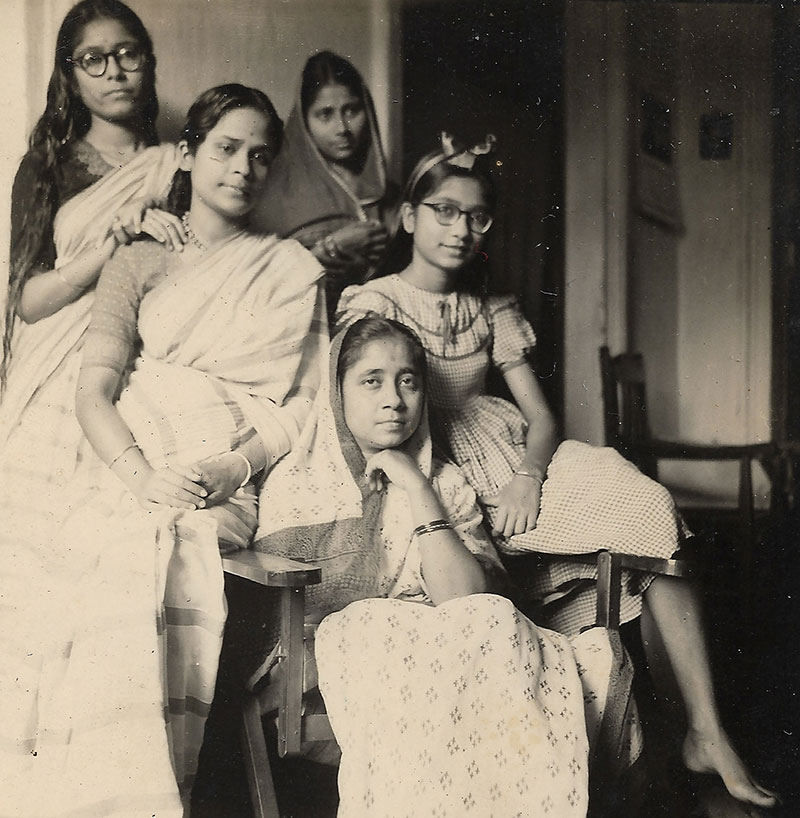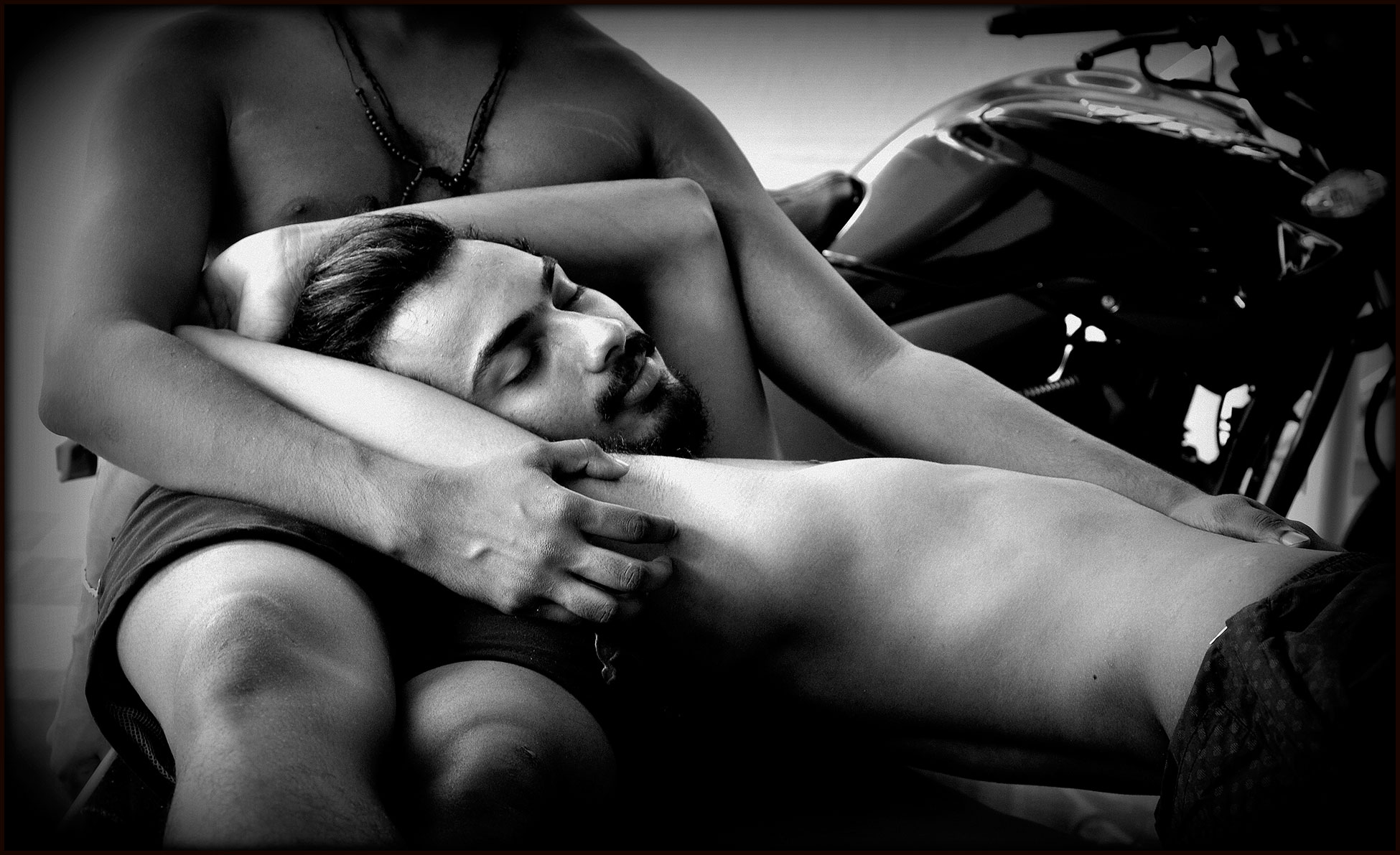Zoom In
PhotoMail constructively and
Critically zooms into
The life and work of photographers
Their art and techniques
Contemporary theory
Aesthetics, material philosophy and
Sociology
Reading of Indian Photographer
Hariharan’s
Barbecue Republic
Exhibited at the Lalithakala Akademi
Calicut and Thrissur, 2022
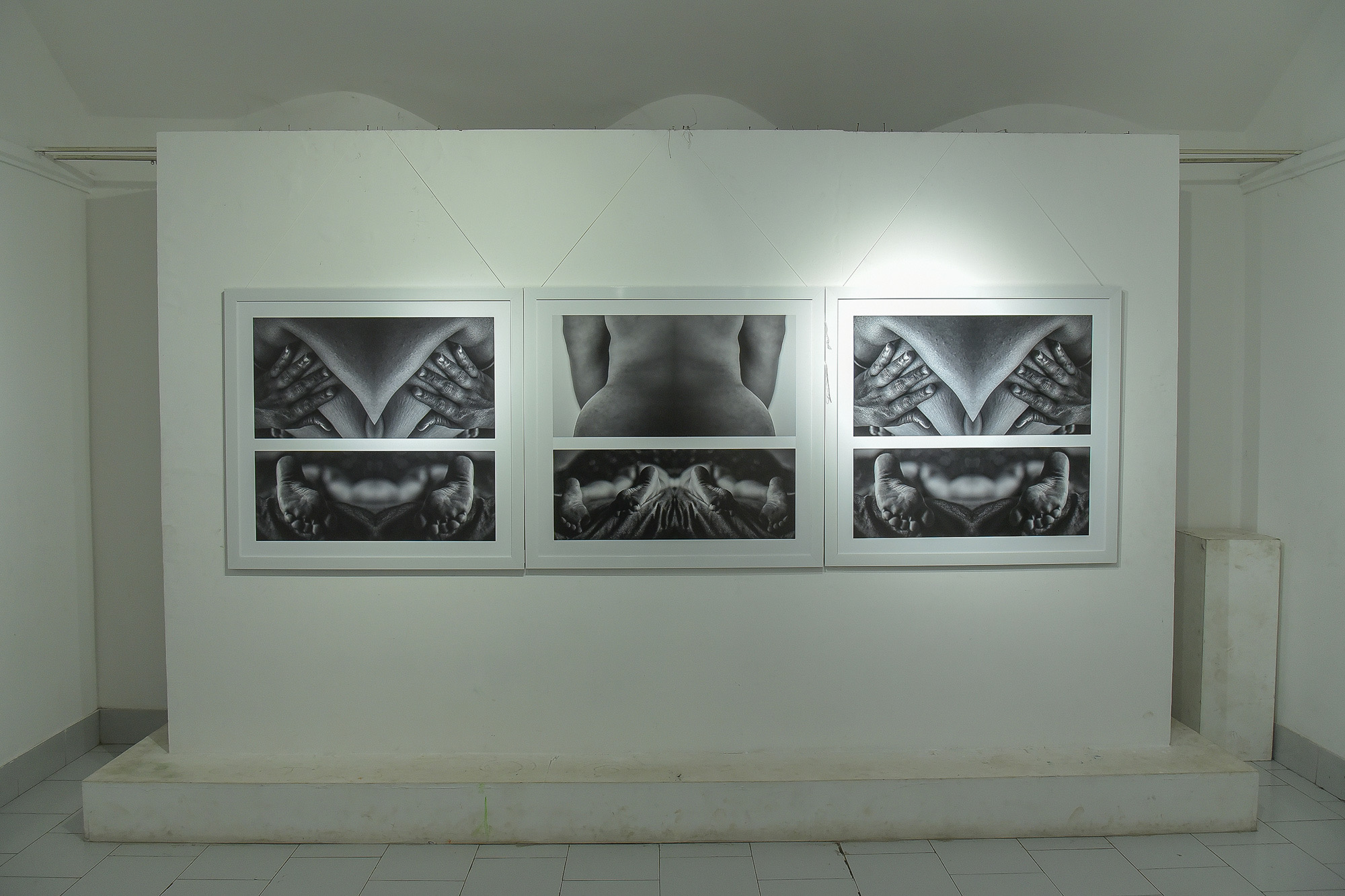
Gallery View, Photographer Hariharan S.’s exhibition, Barbecue Republic, Lalithakala Akademi, Calicut & Thrissur, 2022 | Image courtesy: Hariharan S.
Climbing the insurmountable summit
On an overcast evening a few years back, I found myself waiting at the door of a room full of Petri dishes and test tubes. The smell of strong chemicals was making my stomach growl. I was worried that I might throw up. Through the long row of glass shelves, I could see a nurse in a pale-blue overcoat walking towards me. Her gloved hands held a small metal container. Stopping a few yards in front of me she removed its lid. “This is it,” she told me. I threw a glance, but it didn’t seem like anything that I had imagined. My mother had just undergone surgery and the doctor told me that I could see the surgically removed organ. I only had a momentary gaze into the container. What I saw was my birthplace, now reduced to a piece of flesh removed from the body. A cocktail of depressive emotions was brewing inside me. There was shock, bewilderment, repulsion, pain, disgust and gloom. Along with them surfaced a strange nostalgia; the feeling of a deep connection with my past. Even long afterwards that moment, a question used to pop up in my mind at the most unexpected spaces and times. Why did I feel repulsion towards the piece of flesh cut off from my mother?
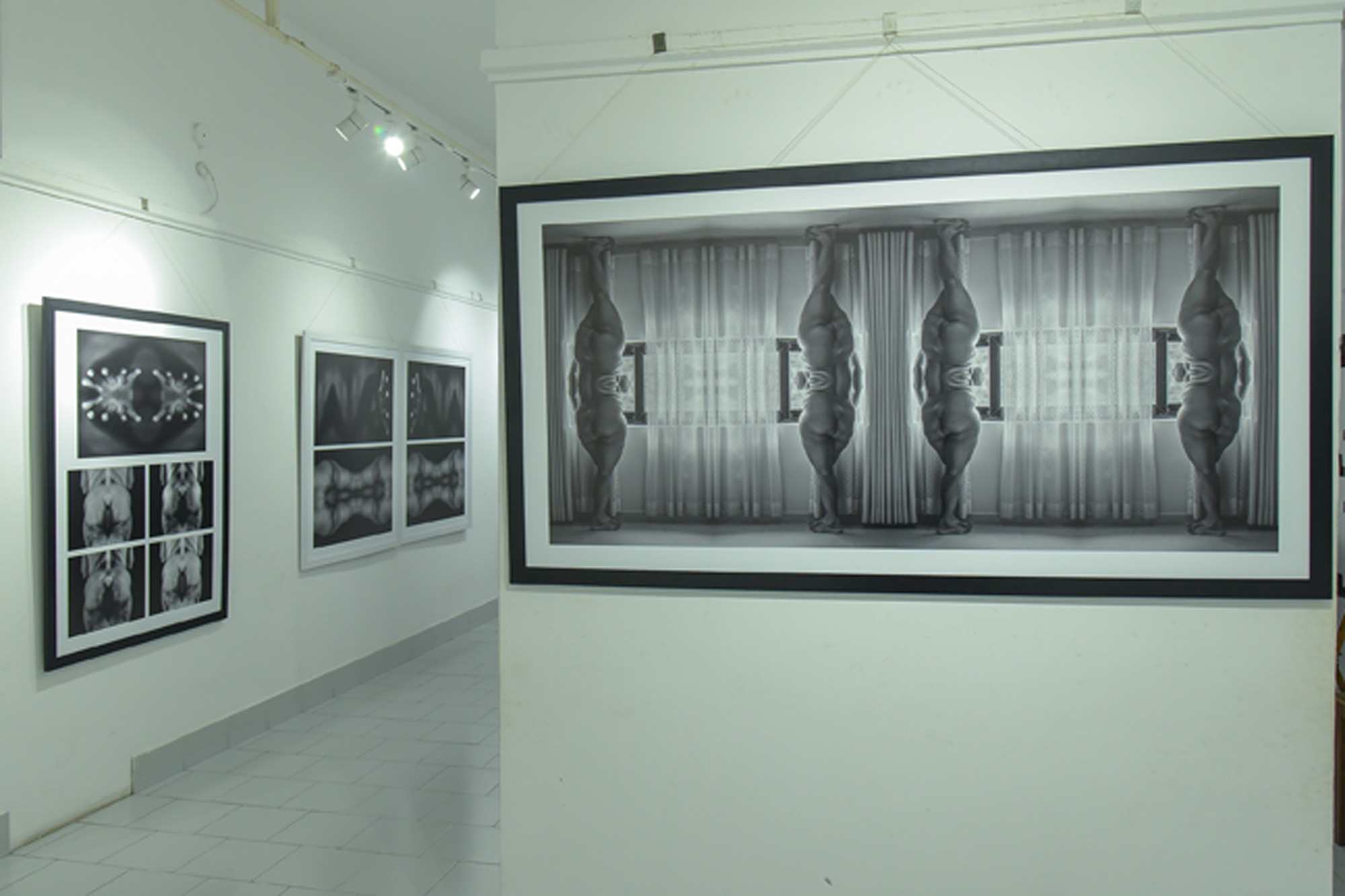
Gallery View, Photographer Hariharan S.’s exhibition, Barbecue Republic, Lalithakala Akademi, Calicut & Thrissur, 2022 | Image courtesy: Hariharan S.
The memories awakened with full force a few weeks ago while I was watching a body of works — titled ‘Barbecue Republic, A Requiem for Flesh’ — created by painter-turned-photo artist Hariharan S. Those images readily triggered a similar repulsive reaction that I had felt inside the hospital. The intriguing question – what triggers repulsion or attraction towards a body? – popped up once again. For modern science, there is no enigma attached to this question. It can deploy arms like cognitive psychology or evolutionary biology to give tailor-made answers. But when it comes to art, any discussion about the body opens a pandora’s box. Hariharan’s work offers a frame to find some meanings to this discussion. While trying to dissect ‘Barbecue Republic’, I stumbled upon three sets of words — ‘nude’ and ‘naked’, ‘beauty’ and ‘ugly’, ‘body’ and ‘flesh’. These words can act as beacons to ensure that we are not strayed off course in the conflicted territory.
If I borrow from art’s lexicon, the female body is the object and its representation is the subject in ‘Barbecue Republic’. The body here is naked but not in the way it is often imagined. Instead of creating a nude, Hariharan uses technology to bewilder the human eye. There is nothing unexceptional to this approach. Throughout the course of time, artists of different hues and shades have used body parts – of their own and of others – for artistic pursuits. And they have elevated the portrayal of the ‘naked’ body into a pedestal named ‘nude’. There are umpteen definitions differentiating the naked from the nude. Modern philosophers like John Berger, however, considered this as mere wordplay. “All nudes have been naked,” Berger felt. However, any effort to differentiate between the nude and the naked in ‘Barbecue Republic’ is meaningless as the artist has dissected the body into several parts and morphed and cloned them to create a photographic symmetry, which usually eludes a normal human body. It is as if the body is present and absent at the same time in Hariharan’s prints.
The portrayal of the female body by any male artist will readily attract scrutiny in the contemporary art world. However, this shouldn’t be stopping artists from working on the subjects of their choice. At the same time, it would be worth touching upon the lack of parity when it comes to the number of male and female artists in the modern art market. A study in 1989 by the artist group Guerilla Girls revealed that just 5% of the artists in the modern art collections in the US were female while 85% of the nudes were female [1]. Three decades later, another study by the National Museum of Women in the Arts found that things didn’t improve at all. Their survey found that 87% of artists were men in the modern art collection of museums in the US. As a result of such huge disparity, the male gaze keeps on reinforcing the dominant ideas about the female body. There have been attempts by women to upset this bias. Photographers like Denisse Ariana Pérez specialize in photographing men and their bodies. She sees the female gaze, opposite to the male gaze, as the incorporation of a lot of care and empathy into the photographing process.
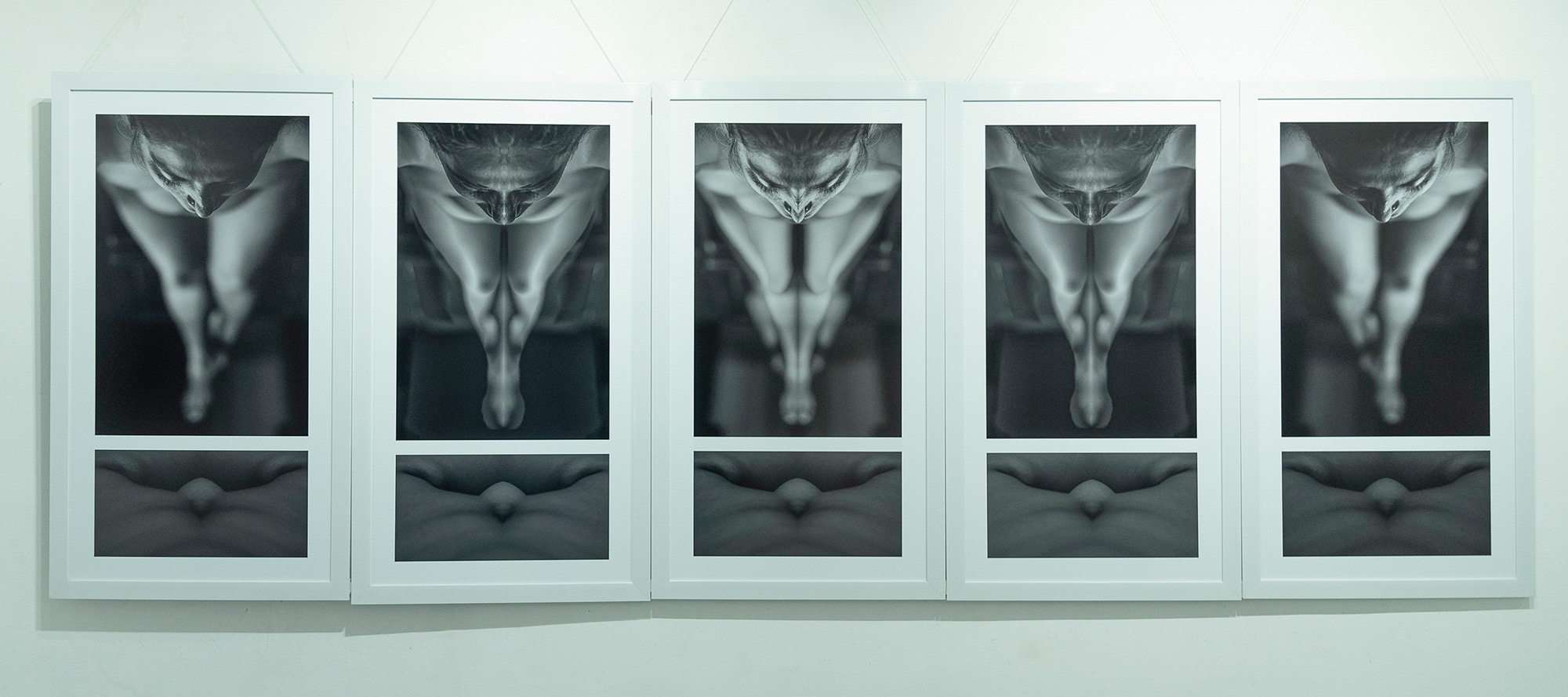
Gallery View, Photographer Hariharan S.’s exhibition, Barbecue Republic, Lalithakala Akademi, Calicut & Thrissur, 2022 | Image courtesy: Hariharan S.
Hariharan’s intentional move to create ugliness brings ‘Barbecue Republic’ into the middle of another whirlpool. What constitutes beauty and ugliness is an ongoing debate and, in all likelihood, there may never be a consensus over it. While we are familiar with the aesthetics of beauty, the aesthetics of ugliness is still a hot potato. Does ugliness have aesthetics? There are arguments that there can’t be an aesthetic judgment of ugliness. Those in favour of this argument say that aesthetics should be judged from a point of detachment. The judge should not feel possessive or attached towards the artwork. However, ugliness automatically evokes repulsion or disgust. So, how could there be an aesthetic judgment of ugliness in art? Defending the aesthetics of ugliness, 19th-century German philosopher Karl Rosenkranz said “negation of beauty without being reducible to evil, materiality or other negative terms and for traditional condemnation” imparted aesthetics to ugliness. More than aesthetics, it is the politics behind the portrayal of female beauty that requires scrutiny in our times.
In any patriarchal society, the female body is tied to the pillars of ownership and property. Such societies don’t allow women to make choices about their bodies, and even force them to practice and propagate the idea of impurity. Conversely, the capitalist ecosystem uses the female body as an object to create the illusion that women do have choices. This is most visible in the cosmetics, grooming and healthcare industries. They compete among themselves to represent the female body in such a way as to attract consumers who feel less confident about their own bodies. These ‘ideal’ female bodies are so rare and they create an unachievable goal for those seeking eternal beauty. As the corporate capital, emboldened by its success, bids to inject more symmetry into the human body, we might even get increasingly detached from the idea of beauty. Stung by the increasing criticism over the objectification of women, several cosmetic companies are now tuning into using ‘normal’ women or doing away altogether with the practice of showcasing ultra-fair complexion as the desired objective. This, however, doesn’t necessarily mean an end to the objectification of the female body. Italian philosopher Umberto Eco (1932-2016) gave a coin-like metaphor for this dichotomy. “Once you set a criterion for beauty, a corresponding criterion for ugliness always seems to present itself pretty much automatically,” he said. Doesn’t it imply that the definitions for beauty and ugliness are created by humans – mostly men — and are subject to changes?
The rarer the beauty is, the more intense the desire to achieve it. Hariharan does the same but in the opposite way. He offers an improbable view of the female body. Such a level of disfigurement and ugliness in a human body is almost impossible that Hariharan had to create ugliness using technology literally. However, there is a catch. The discourse on aesthetics also speaks about symmetry. There is a belief that only beautiful things are ordered in a symmetric way, and ugliness stems from a lack of symmetry. However, there is a symmetry carefully crafted with the help of digital technology throughout ‘Barbecue Republic’. It is at this juncture that Hariharan’s prints throw up a dilemma. Did he create something beautiful while intending to create extreme ugliness? Would the images in ‘Barbecue Republic’ have triggered the same sort of repulsion if this symmetry was not enforced?
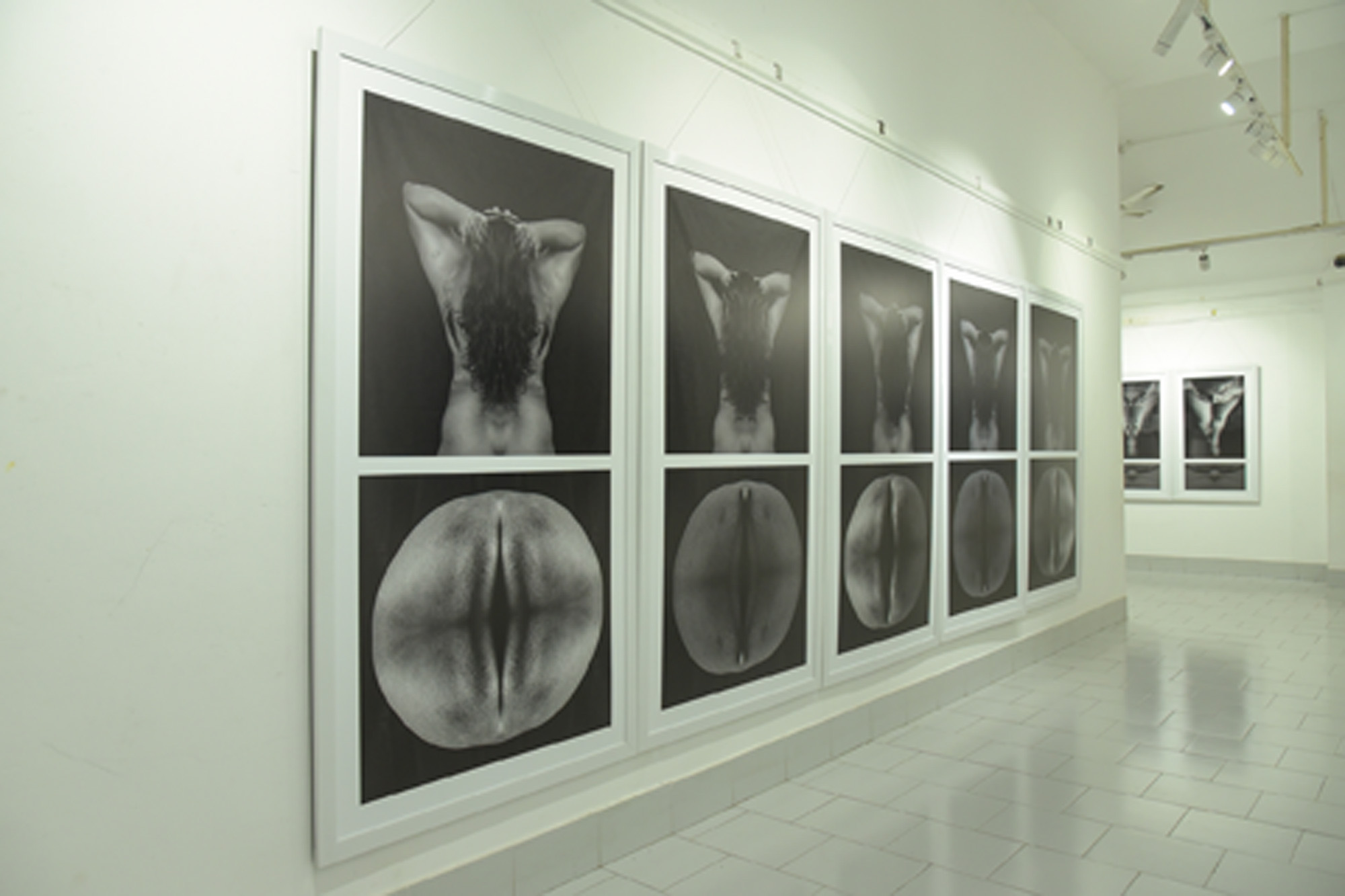
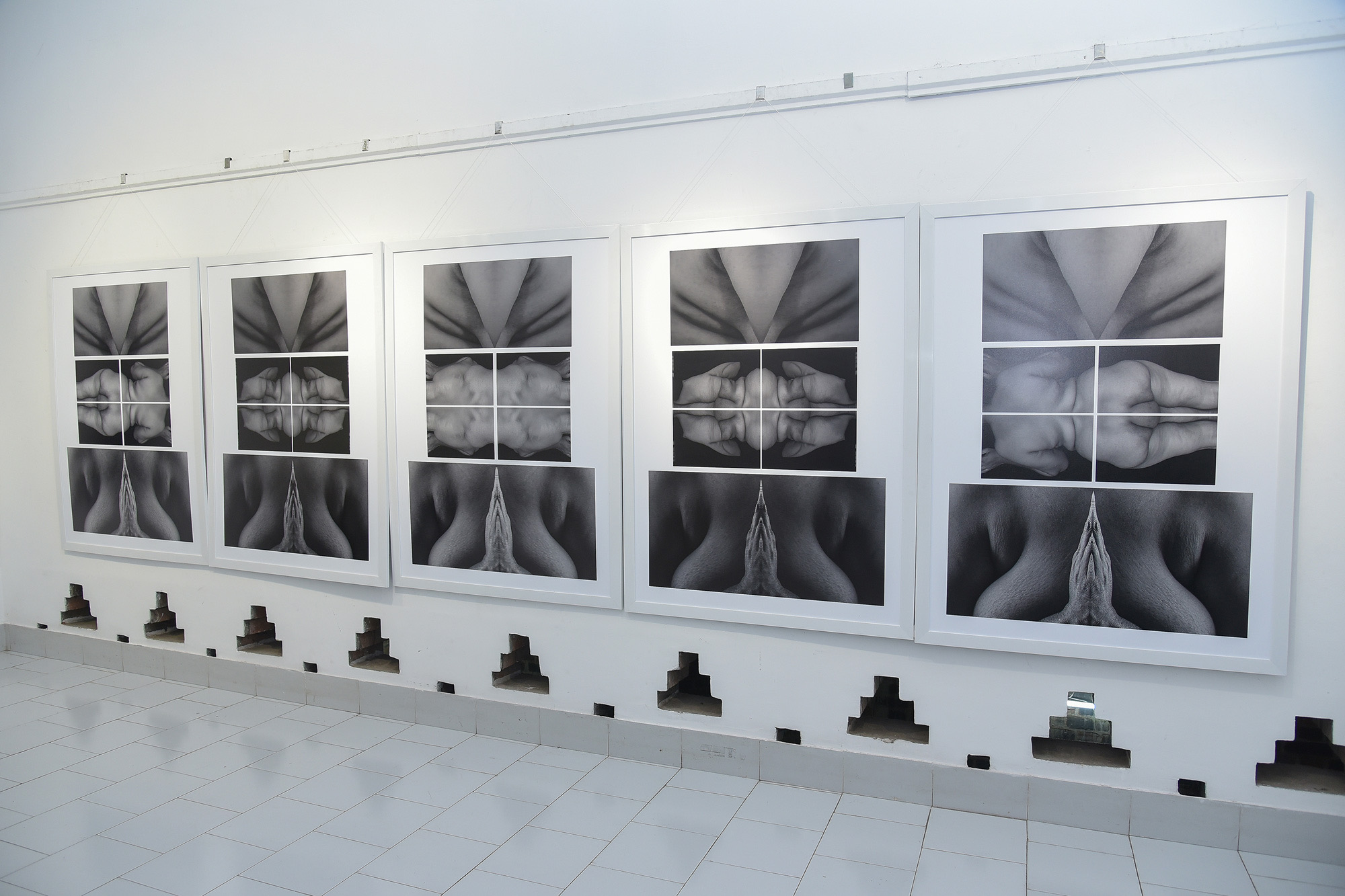
Gallery View, Photographer Hariharan S.’s exhibition, Barbecue Republic, Lalithakala Akademi, Calicut & Thrissur, 2022 | Image courtesy: Hariharan S.
The complicated relationship between ‘body’ and ‘flesh’ is another territory that needs exploration while looking through Hariharan’s work. These words are often used interchangeably, especially by those in the fields of art, literature and social sciences. However, the difference between the two is like an elephant in the room. The female body is often a soft target during political violence across the world. Hariharan states that the ‘Barbecue Republic’ is his reaction to the brutality of political violence faced by women in different parts of the world, including Nazi Germany, Congo and Gujarat. The words ‘body’ and ‘flesh’ could be alternately read as the targets of emotional and physical violence, respectively, towards women during these carnages. The role of photography in making the world empathize with suffering and injustice is unquestionable. However, the use of photography in healing wounds is less discussed. British photographer Jo Spence (1934-1992) [2], known as the pioneer of therapeutic photography, created self-portraits about her own fight with breast cancer in an attempt to subvert society’s ideas about the ideal female body. She firmly believed that photography could be used to make visible the cultural norms that surround us and make us sick. As we sail into the second quarter of the technology-driven 21st century, where gender norms are likely to be more fluid, artists, irrespective of their gender, are expected to ask more questions about themselves while portraying another person’s body.
Any modern-day discussion on the portrayal of the female body will be incomplete without the words of Simone de Beauvoir (1908-1986). The author of Second Sex, one of the most influential works on feminism, considered the body as more than an object. “The body is not a thing; it is a situation. It is our grasp on the world and our sketch of our project.” The virtual world we currently inhabit offers multiple realities to its citizens. We have options to reconfigure or alter our appearances in these realities. People are eager to present a better/more beautiful version of themselves in the online world. Most of us hesitate to post our own photos online without a stroke of retouching. This digitization of appearances focuses on beautifying certain parts or aspects of the body. This can range from merely changing the complexion of the skin to altering the size of body parts. This happens amid the wealthiest of society surgically altering their body parts to suit the contemporary concepts of beauty. However, for the masses, the digital makeover is the only solace as of now. Academics are increasingly using the word ‘digitized dysmorphia’ to understand the trend of people altering their own body images to suit the online world. Here too, it is the women who become the torch-bearers and victims at the same time. It seems the burden on women to appear beautiful is not waning. As we continue to set new criteria for defining beauty and ugliness, if Umberto Eco is true, the exact opposite is also automatically reinventing itself. ‘Barbecue Republic’, through its improbable distortion of the female body, indirectly unveils the insurmountable summit a woman awaits in our world.
As I try to deconstruct the emotions that I felt at the hospital, I am reminded of peeling the onion. A trip to the inner layers could bring up uncomforting questions about the self and the unknown forces that constantly reshape it. Yet, such questions also help us navigate the labyrinth which we call life.
_________
[1] Women Are Finally Eroticizing The Male Nude, Forbes, February 21, 2022
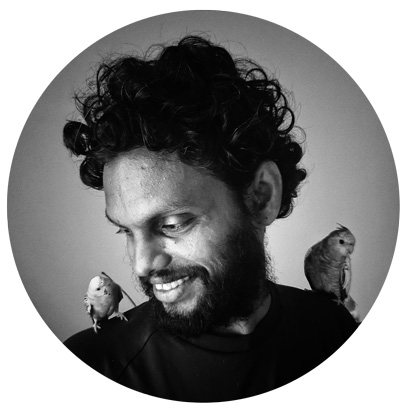
Joyel K Pious is a freelance writer and photographer. Belonging to Thrissur district of Kerala, he is interested in the interwoven relationship of humans among themselves and with nature. He also extends his services as News Editor, PhotoMail.

Starting his artistic sojourn as a painter, Hariharan S. soon took up photography as his medium of expression. His works have been published in national and international magazines and art journals.
See: Hariharan’s Crucifixion: Body and Spirit, Here
Published on January 3, 2023
Share
Related Articles

In my taxi, when a photo artist becomes a cab driver
What motivated Weideman to keep photographing? The answer to this is also an important quality that makes his photographs intriguing. He continued shooting even though he was not exhibiting nor getting into any sort of limelight until the mid-90s. Passion for the medium, of course. But there is more.
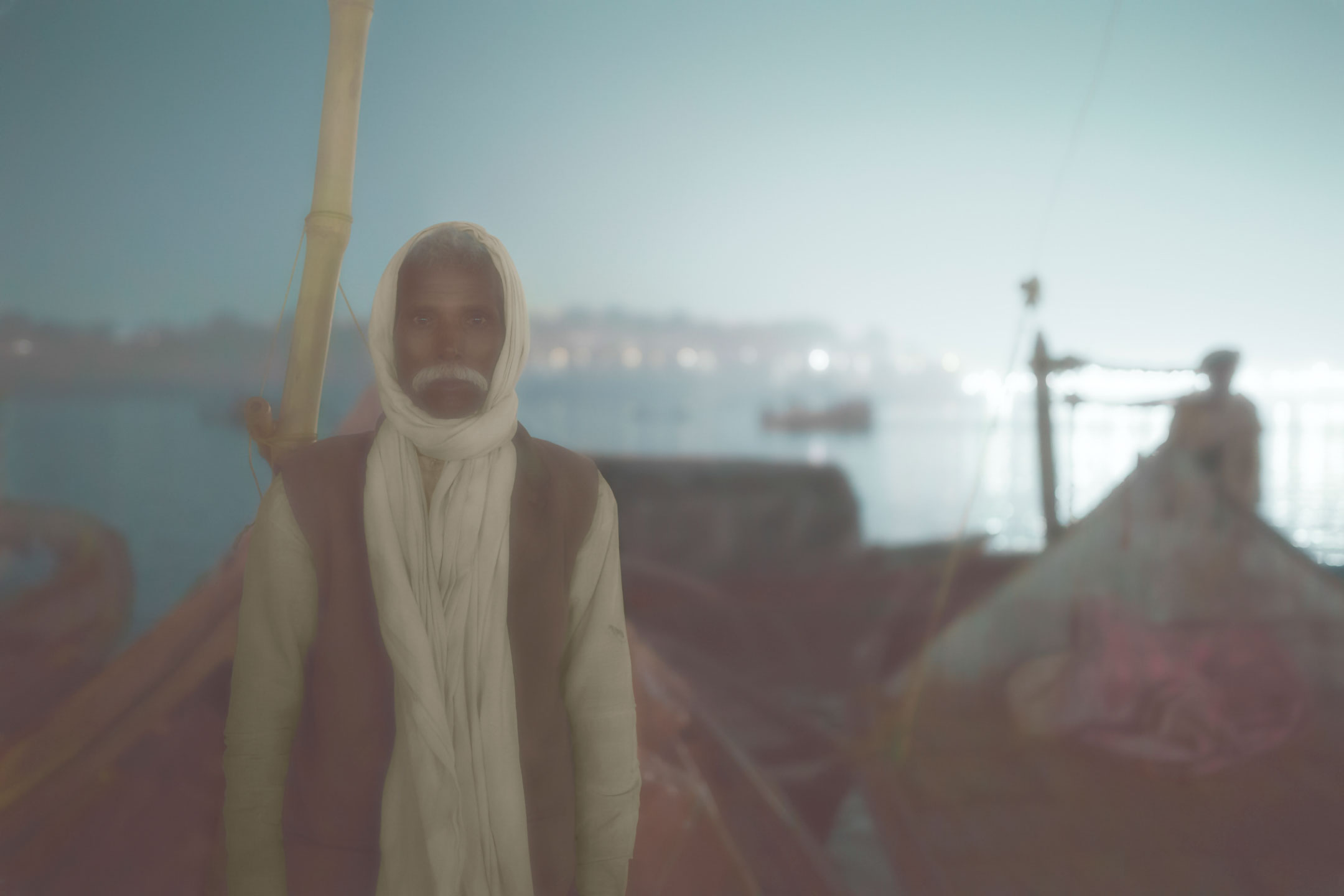
Mallaahs, the boatmen of Gangetic geography, A Photo Art series by Shibu Arakkal
Review of Mallahs, the boat of Gangetic geography, photographic series of Shibu Arakkal. For several hundred years these boatmen on the Ganga and the Yamuna have handed down their oars from father to son. I was intensely drawn to the purpose of their lives, to carry people back and forth on these rivers. Almost married to their boats, these men. To live almost all of their lives on these wooden vessels, going about their worldly chores and belonging to a tribe of menfolk, they pride themselves on being the real caretakers of these mystical rivers. Almost as if they are born on these boats and just as possibly may breath their last on it, the Mallaah men live lives removed from their families and children.
In search of the lost home
Across the world there are ongoing attempts to construct a ‘people’s history’ through photographs. Memory Projects, they are fondly called, focus mainly on the pre-digital era when photography was not as common as today. Bengali photographer Anandarup Goswami’s photography series ‘A Home of No Return’, though not directly linked with any memory project, shows certain resemblances with the latter’s style, and yet carries its own soul. A Home of No Return visually narrates the past and the present through a mixture of faded and fresh photographs.
Homomorphism II
The LGBTQ community has found for itself public spaces in urban regions. We will wait and see what they want to tell the world from that space. After all, solidarity with the cause does not mean solidarity with the acts, and it is time for the community to begin to act convincingly. This exhibition is a good starting point, and further on, there is a desperate need for clarity on the part of the activist-artists.

Elements and Fragments, Uncovering Narratives of a Temple Town
Inasmuch, every photographer that ever visited Tiruvannamalai never took notice about anything other than Ramana and the Annamalaiyar temple – their eyes glossing over everything else and their focus devoted entirely to the two ‘divine’ icons. But, there remains a Tiruvannamalai beyond, which has gone unnoticed and undocumented – invisible to the colonial gaze that is pre-occupied with its exotic fairy tales, and underwhelming for the photojournalist due to its perceived mundane-ness.


